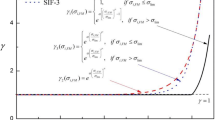Abstract
Conventional topology optimization is concerned with the structures modeled by classical theory of mechanics. Since it does not consider the effects of the microstructures of materials, the classical theory can not reveal the size effect due to material’s heterogeneity. Couple-stress theory, which takes account of the microscopic properties of the material, is capable of describing the size effect in deformations. The purpose of this paper is to investigate the formulation for topology optimization of couple-stress material structures. The artificial material density of each element is chosen as design variable. Based on the basic idea of SIMP (Solid Isotropic Material with Penalization) method, the effective material stiffness matrix of couple-stress material is related to the artificial density by power law with penalty. The structural analysis is implemented by finite element method for couple-stress materials, and a 4-noded quadrilateral couple-stress element is formulated in which C 1 continuity requirement is relaxed. Some typical problems are solved and the optimal results based on the couple-stress theory are compared with the conventional ones. It is found that the optimal topologies of couple-stress continuum show remarkable size effect.
Similar content being viewed by others
References
Adhikary DP, Guo H (2002) An orthotropic Cosserat elasto-plastic model for layered rocks. Rock Mech Rock Eng 35:161–170
Bendsøe MP (1989) Optimal shape design as a material distribution problem. Struct Multidisc Optim 1:193–202
Bendsøe MP, Kikuchi N (1988) Generating optimal topologies in structural design using a homogenization method. Comput Methods Appl Mech Eng 71:197–224
Bendsøe MP, Sigmund O (2004) Topology optimization: theory, methods and applications. Springer, Berlin
Bigoni D, Drugan WJ (2007) Analytical derivation of Cosserat moduli via homogenization of heterogeneous elastic materials. J Appl Mech 74:741–753
Bouyge F, Jasiuk I, Boccara S et al (2002) A micromechanically based couple-stress model of an elastic orthotropic two-phase composite. Eur J Mech A, Solids 21:465–481
Burgueno R, Quagliata MJ, Mohanty AK et al (2005) Hierarchical cellular designs for load-bearing biocomposite beams and plates. Mater Sci Eng A 390:178–187
Dai GM, Zhang WH (2008) Size effects of basic cell in static analysis of sandwich beams. Int J Solids Struct 45:2512–2533
Eringen AC (1966) Linear theory of micropolar elasticity. J Math Mech 15:909–923
Eringen AC (1999) Microcontinuum field theories, vol 1. Springer, New York
Fatemi J, Van Keulen F, Onck PR (2002) Generalized continuum theories: application to stress analysis in bone. Meccanica 37:385–396
Fleck NA, Muller GM, Ashby MF et al (1994) Strain gradient plasticity: theory and experiment. Acta Metall Mater 42:475–487
Forest S, Barbe F, Cailletaud G (2000) Cosserat modelling of size effects in the mechanical behaviour of polycrystals and multi-phase materials. Int J Solids Struct 37:7105–7126
Jasiuk I, Ostoja-Starzewski M (1995) Planar Cosserat elasticity of materials with holes and intrusions. Appl Mech Rev 48:11–18
Lakes RS (1986) Experimental microelasticity of two porous solids. Int J Solids Struct 22:55–63
Mindlin RD (1963) Influence of couple-stresses on stress concentrations. Exp Mech 3:1–7
Nowacki W (1986) Theory of asymmetric elasticity. Pergamon, Oxford
Rovati M, Veber D (2007) Optimal topologies for micropolar solids. Struct Multidisc Optim 33:47–59
Sigmund O (2007) Morphology-based black and white filters for topology optimization. Struct Multidisc Optim 33:401–424
Soh A-K, Chen W (2004) Finite element formulations of strain gradient theory for microstructures and the C0–1 patch test. Int J Numer Methods Eng 61:433–454
Wood RD (1988) Finite element analysis of plane couple-stress problems using first order stress functions. Int J Numer Methods Eng 26:489–509
Zhang W, Sun S (2006) Scale-related topology optimization of cellular materials and structures. Int J Numer Methods Eng 68:993–1011
Zhang H, Wang H, Liu G (2005) Quadrilateral isoparametric finite elements for plane elastic Cosserat bodies. Acta Mech Sin 21:388–394
Zheng C-l, Ren M-f, Zhang Z-f et al (2004) Analysis of elastic Cosserat medium using discrete Cosserat finite elements. Chinese Journal of Computational Physics 21:377–382
Zienkiewicz OC, Taylor RL, Zhu JZ (2005) The finite element method: its basis and fundamentals. Elsevier/Butterworth-Heinemann, Oxford
Author information
Authors and Affiliations
Corresponding author
Rights and permissions
About this article
Cite this article
Liu, S., Su, W. Topology optimization of couple-stress material structures. Struct Multidisc Optim 40, 319–327 (2010). https://doi.org/10.1007/s00158-009-0367-3
Received:
Revised:
Accepted:
Published:
Issue Date:
DOI: https://doi.org/10.1007/s00158-009-0367-3




